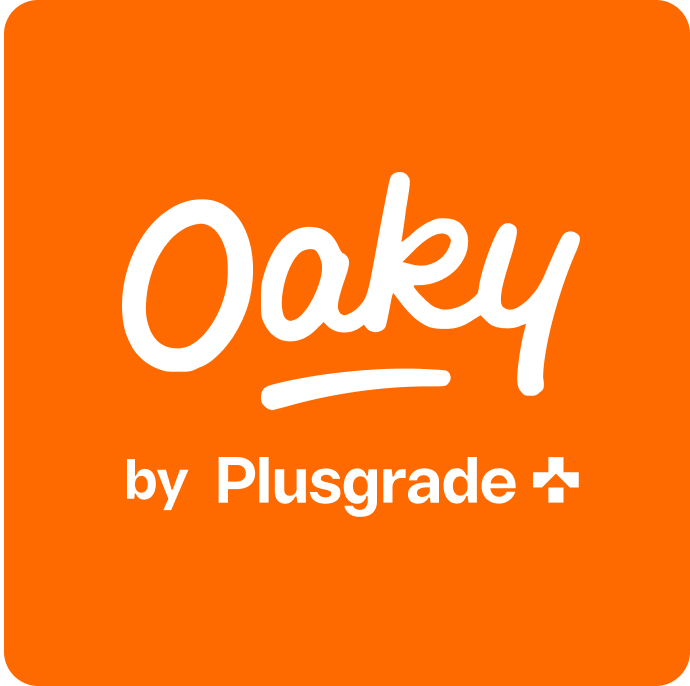17 Hotel pricing strategies to grow your revenue
Oaky
•

An effective hotel pricing strategy grows your occupancy rate and profit margins simultaneously. Instead of trying to sell all the hotel rooms all the time (which is an unrealistic goal), hotel pricing strategies focus on finding the optimal rate for your target market so that you attract the right business at the right price.
The following are common hotel pricing strategy examples that are used by hotels of all shapes and sizes—from smaller independent ones to large branded chains. Like your room rates, these strategies should also be changed up. Travel demand fluctuates and a static pricing model may lead to lost opportunities or reduced occupancy. So, be sure to read till the end.
Key takeaways: How to build a profitable hotel pricing strategy
Focus on total revenue (TRevPAR): Look beyond RevPAR and occupancy and aim to generate total revenue from your entire inventory and outlets, such as room upgrades, F&B, spa, transportation, services, and experiences, increasing average spend per guest.
Don’t discount—add value: Bundle rooms with services or create upsell packages instead of slashing prices, protecting both margins and brand perception.
Embrace dynamic pricing: Adjust rates in real time to balance demand, seasonality, and competitor actions instead of relying only on cost-based models.
Forecast smarter, not harder: Use historical booking data, demand patterns, and even AI-driven forecasting tools to set prices proactively rather than reactively.
Price for segments, not just seasons: Tailor rates to guest types (business travelers, groups, loyalty members, etc.) to capture more value per booking.
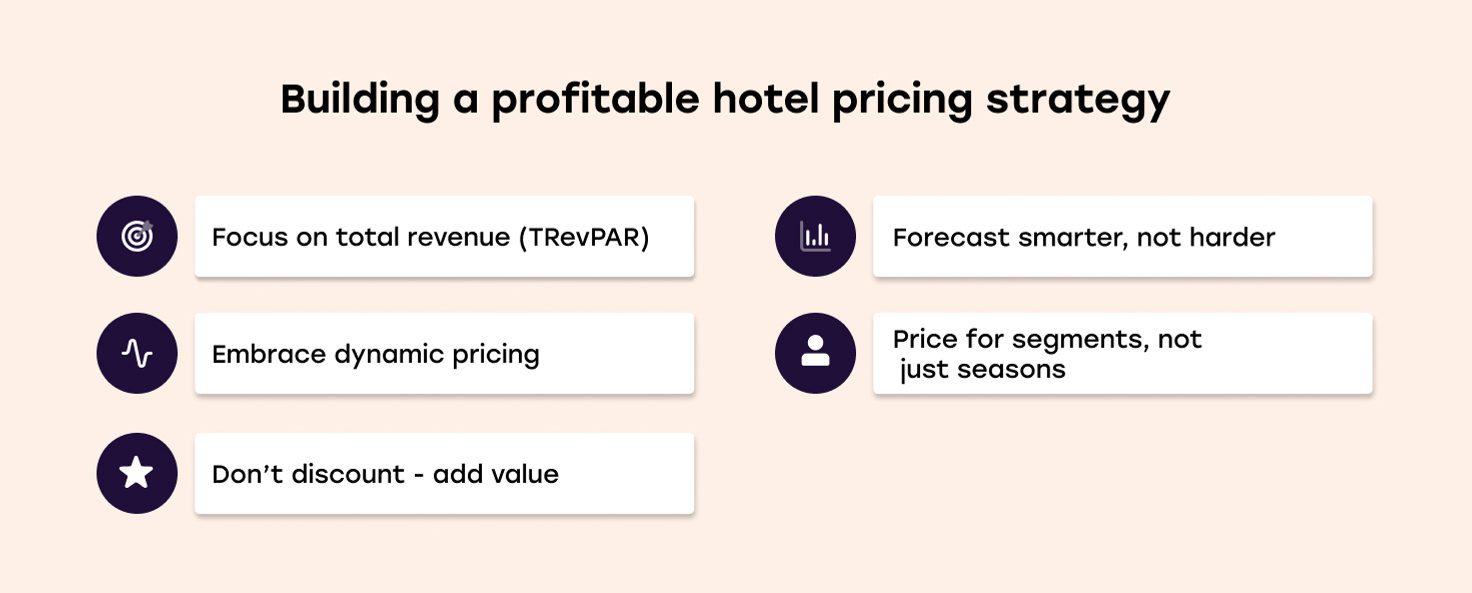
What is a hotel pricing strategy?
A hotel pricing strategy refers to the way hotels determine the price for their rooms, amenities, and/or add-on services. The goal is to balance demand, operational costs, competition, and guest expectations so that it charges the optimal price to the right guest at the right time.

Why is hotel pricing strategy important?
Your hotel pricing strategy will directly impact your revenue growth. Here’s how:
1. Maximizes revenue (TRevPAR and ADR)
The right strategy helps align occupancy with room rates to ensure that you earn the most possible revenue from each room without losing bookings. This way, you’ll fill your rooms more profitably, increasing the total revenue per available room (TRevPAR) and average daily rate (ADR).
2. Adapts to demand and market changes
Customer demand fluctuates by season. Plus, it’s not just the literal weather that you need to account for as factors like events or competitor actions can draw more guests to your hotel’s location or away from your establishment.
A smart pricing approach lets you stay competitive compared to nearby hotels without undervaluing your rooms. You’ll be able to plan special offers, length-of-stay discounts, or upselling opportunities to meet current and future demand, allowing you to generate revenue in spite of unpredictable market shifts.
3. Shapes guest perception of value
Price signals quality. If set too low, guests may assume poor quality. On the other hand, if it’s too high, you can expect demand to drop.
A strategic approach positions your hotel correctly in the market. You can use it to reinforce exclusivity or capture the attention of price-sensitive travelers.
4. Strengthens long-term competitiveness
A solid strategy makes it easier to forecast revenue, attract the right guests, and build loyalty. Rather than chasing short-term occupancy over and over gain, you’ll be in a position to generate predictable, optimized revenue.
What are the different types of hotel pricing strategies?
Whether achieving optimal occupancy, delivering more value, or building trust and loyalty among specific segments is the goal, the following 17 strategies will ensure you make more strategic price changes.
- Core pricing strategies
The following are the most commonly used hotel pricing strategies, making them a good place to start:
1. Cost-based pricing
Also called cost-plus pricing, this hotel pricing strategy applies a markup to each room rate. This markup is determined by calculating all the costs, from administration and cleaning to food and beverage, and more, and adding your desired profit margin.
It’s one of the most straightforward ways that hotels set their rates. While it takes your expenses into account, it ignores market conditions.
For example, during high-demand periods like holidays, you run the risk of being underpriced and missing out on opportunities when higher room rates are justified.
2. Dynamic pricing
With a dynamic pricing strategy, hotels adjust rates in real time based on market demand, seasonality, and competitor prices. For example, when travel demand rises, hotels will charge higher rates. Then, when demand decreases again, rates will be lower.
The goal is to maximize revenue and occupancy by selling rooms at the highest price guests are willing to pay. To keep it fair and effective, hotels should avoid too significant and/or frequent price fluctuations.
3. Length-of-stay pricing
As the name suggests, this hotel pricing strategy uses the length of a guest’s stay as a criterion to determine the rate, offering discounts or incentives for longer stays to increase occupancy. It can also consider factors like:
Check-in date
Current supply
Demand forecasts.
The benefit of this strategy is that it allows you to charge one rate for the entire duration of your guest’s stay.
It’s especially effective when used in conjunction with local events. You might require a minimum length of stay for the duration of an event to secure bookings and increase the number of nights your guests stay at your hotel.
4. Occupancy-based pricing
An occupancy-based strategy works based on supply and demand. In short, it uses supply and demand to determine hotel rates. Essentially, when demand exceeds supply, you increase your room rates. Then, when demand drops, you’ll switch to lower rates to boost occupancy in the downtime.
It’s an effective way to grow room revenue, making it one of the most common pricing strategies in the hotel industry. While it uses demand, it ignores external demand factors like local events.
There’s also a risk that you might decrease your rates too aggressively when occupancy is low. This can damage brand value, making it a less appealing strategy for boutique and luxury hotels.
5. Event-based pricing
With event-based pricing, you’ll monitor local calendars closely and adjust rates during holidays, festivals, or conferences when demand spikes. This is a form of dynamic pricing that also works well with value-added packages, upselling, and cross-selling.
You can, for example, create an exclusive, event-related package that includes late checkout (which will be much appreciated after a night out) to give your hotel a competitive advantage. Alternatively, you can simply suggest separate add-ons like a spa treatment or shuttle service.
6. Forecasting-based pricing
Forecasting is an effective strategy to set prices based on what you expect the demand to be. You’ll need access to your hotel’s:
Occupancy rates
Room rates
Average spend per room.
It requires a comprehensive approach as you’ll need to compare these numbers for the most recent months as well as for the same period last year. Using this historical data, you can predict future room availability more accurately and implement data-driven adjustments.
This way, you can confidently increase your prices in advance, even when your current occupancy rate is still low. On top of that, it can also help with operational planning as you’ll have better insight into your upcoming staffing needs.
If you plan on implementing this room pricing strategy, it’s essential that you’re not too rigid in your approach. You’ll still need to follow emerging market shifts and be ready to adapt quickly to unexpected events.
- Guest segmentation and value-based strategies
The following strategies work especially well if you’re targeting specific guest types or want to grow your TRevPAR:
7. Segmentation pricing
Also called guest-type pricing, segmentation pricing tailors room rates for different guest types, e.g., business travelers, groups, loyalty members, etc. Factors that you’ll use to determine a segment’s special rate include:
Guest segment (business, leisure, etc.)
Booking channel (direct, OTA, etc.)
Purpose of their stay
Age
Location
Occupation
Guest preferences
Booking volume (the number of rooms that get booked at the same time).
In practice, this means that walk-in guests will be charged a higher rate for the same room than pensioners who like to book a stay at your hotel once a year.
While this can strengthen relationships with guests who generate quality business, others may feel cheated if they discover they paid more for the same room type.
8. Upselling
By applying upselling, you’ll differentiate between your standard and premium rooms and allow guests to upgrade to the better room at the time of booking, pre-arrival, or at check-in. You can also charge extra for add-ons like views of the garden, amenities, or convenience (e.g., easy access to the beach).
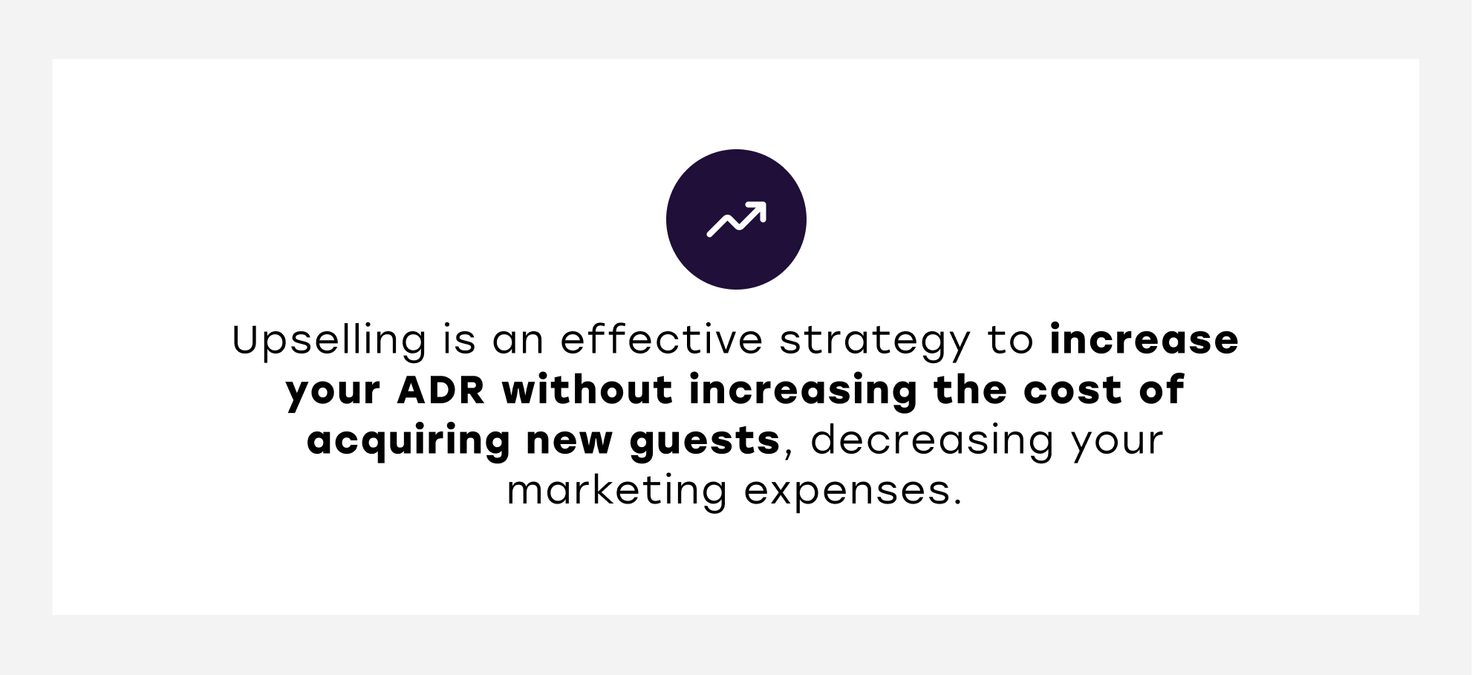
What makes this strategy attractive is that it lets you increase your average daily rate without increasing the cost of acquiring new guests, decreasing your marketing expenses. It also maximizes inventory value as you can push premium rooms that might otherwise remain unbooked.
Guests also benefit. The personalized upgrade offer will make them feel valued, and the fact that they’ll be staying in a premium room will improve the overall guest experience
9. Cross-selling
Cross-selling is similar to upselling. However, instead of focusing on selling more expensive room types, you’ll encourage guests to purchase additional services or products. It’s a revenue-boosting strategy as it helps you to increase your revenue per booking to increase the overall profitability.
Like upselling, this strategy also enhances the guest experience. You can, for example, suggest:
A spa treatment
Restaurant reservation
Airport transfer
Guided city tour
Early check-in/late checkout.
Explore how hotels worldwide use automated upselling
10. Bidding on upgrades
Bidding on upgrades is a guest-driven revenue strategy where hotels let guests submit the price they’re willing to pay for room upgrades. This allows the property to generate additional revenue while giving guests a sense of control over their stay. However, smart safeguards ensure bids always align with your pricing and availability.
Another advantage of this strategy is that it allows you to promote premium room types and avoid giving them away. In fact, according to our data, Bidding in Oaky’s pilot hotels increased room revenue by 17%, and conversion rate by almost 50%.
Most importantly, Bidding helps hoteliers get real insight into guests’ willingness to pay and validate upgrade rates. They can use these insights to upsell more effectively before arrival and at check-in.
11. Value-added packages
With this strategy, you’ll bundle rooms with food and beverage deals, spa treatments, or local experiences to create perceived value without discounting your room rate. Instead, the total cost of the package will be slightly less than what it would cost to buy the room and add-on services separately. Even if the package ends up costing the same price, the convenience of not having to book these services separately can offer enough value to guests.
It’s another way to increase your ADR. Plus, when it’s offered exclusively as an in-app deal, it becomes an attractive incentive to encourage direct bookings.
When going this route, you can create various packages based on the customer segments that you target. For example, if you want to attract more business travelers, you can create a value-added package that includes free uncapped Wi-Fi, meeting room facilities, dry-cleaning, airport transfer, and breakfast.
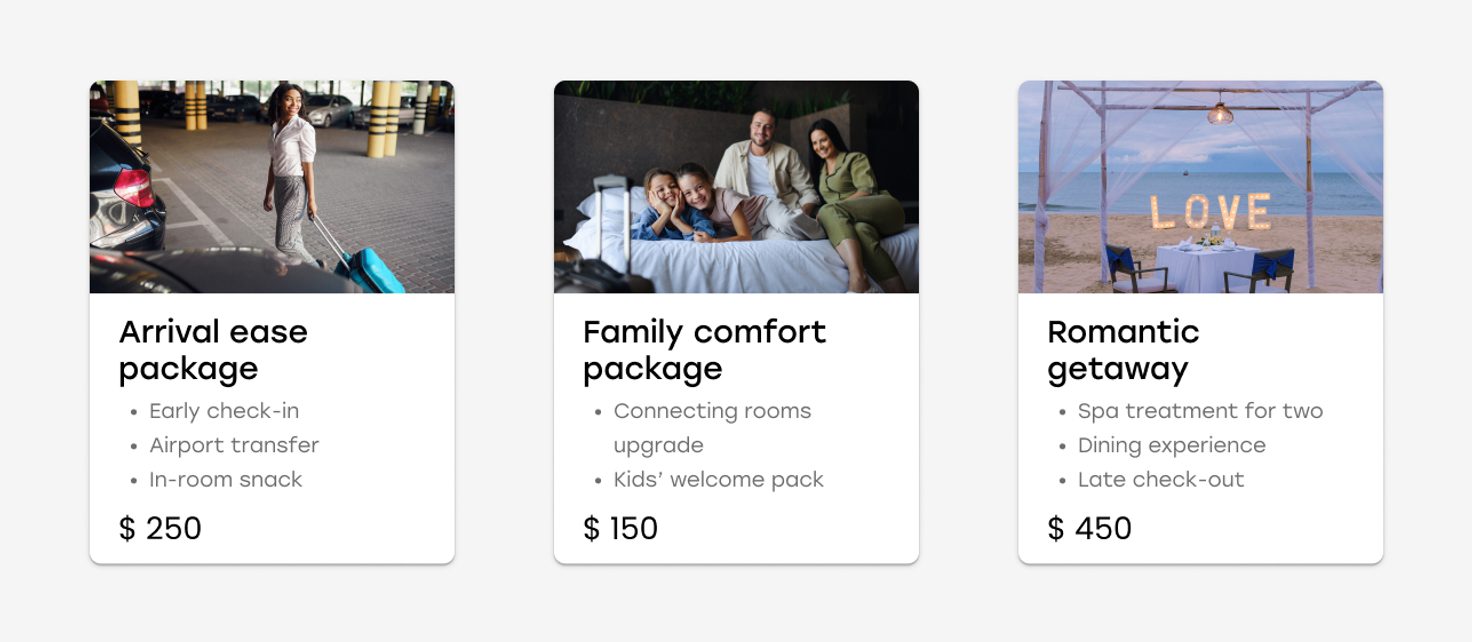
- Competitive and distribution strategies
Hoteliers who want to use and target multiple platforms and regions can explore these three strategies:
12. Best available rate (BAR)
This is one of the most common strategies where hotels offer flexible rates that reflect market conditions while staying competitive. Using this strategy, hotels offer the lowest available rate to the public for a specific room type.
That said, it’s not necessarily the best available deal for guests. For example, if they book early or join a loyalty program, they might be able to get a better deal.
13. Rate parity
With rate parity, you’ll maintain consistent rates across all distribution channels like your own website, OTAs, and global distribution system (GDS). It’s more transparent than many of the other hotel pricing strategies, helping to build brand trust.
While this strategy means that you can’t increase the room rate on OTAs to offset the commission, you can use other marketing strategies to encourage direct booking instead. You can, for example, offer a free breakfast or late checkout, making direct bookings seem like more value for money even though they charge the same room rate.
14. Geo-targeted pricing
Geo-targeted pricing is a strategy where hotels adjust rates based on the guest’s country or region. For example, they might offer discounted rates to domestic travelers, while charging higher rates to international tourists.
In fact, for hotels based in regions like Africa or India, using this pricing strategy means that local as well as international travelers will be charged a fair rate. International travelers from regions like the United States and Europe with stronger currencies often benefit from favorable exchange rates. Geo-targeted pricing allows hotels to align pricing with international travelers’ willingness to pay without alienating the domestic market.
- Discount and loyalty-based strategies
The following pricing methods are best used carefully:
15. Advance purchase rates
Advance purchase rates offer discounts for guests who book early. It’s usually applied to bookings made months or weeks in advance. The earlier the booking, the greater the discount.
As hotels receive money upfront, it helps improve cash flow. It also reduces uncertainty by locking in bookings long before the check-in date. However, the drawback is that you’ll have less flexibility to adjust room rates closer to arrival if demand turns out to be higher than expected.
16. Last-minute pricing
When hotels apply last-minute pricing, they adjust the room price close to the check-in date to help fill unsold rooms. Hotels typically start to lower prices a week before check-in.
The reasoning is that selling a last-minute room, even at discounted rates, is better than leaving it empty. That said, it’s a reactive strategy that becomes risky if overused, as you can train guests to wait for discounts. Pre-arrival upselling, on the other hand, can prevent you from heavily discounting your rooms to ensure occupancy and maximize revenue by letting you fill premium rooms and resell standard ones to last-minute guests.
17. Loyalty and corporate pricing
With this strategy, you’ll be offering exclusive rates to repeat guests or for corporate contracts. To qualify for this reduced rate, guests typically have to join a hotel loyalty program. This way, you also grow your direct bookings and customer data, which you can use to improve your marketing campaigns.
What factors influence hotel pricing?
As these hotel pricing strategies show, rates are rarely set randomly. It considers a mix of factors like:
Supply and demand: When demand is high, hotels can afford to raise rates as there will be more travelers competing for limited accommodation.
Market trends: Seasonal fluctuations, special events, and changing consumer behavior force hotels to adapt their offering to match what guests are currently seeking. For example, growing interest in sustainable travel allows eco-friendly, independent hotels to charge more.
Competitor pricing: To avoid losing business, hotels may need to drop their rates to stay in line with what similar properties currently charge their guests.
Operational costs: Expenses such as staff wages and utilities also influence hotel prices. These combined costs set the baseline for pricing. If any one of these expenses increase, you can expect hotels to adjust their pricing accordingly in order to maintain the same profit margins.
How do hotels maximize revenue through pricing?
Maximizing occupancy alone doesn’t equal profit.
Hotels need to balance room rates, occupancy, and guest segmentation strategically to capture the highest possible revenue per available room (RevPAR). This way, they don’t rely on frantic discounts, which can harm their brand and revenue potential to attract more bookings.
Instead, they can use pricing strategies to find that sweet spot, ensuring each room is sold at the highest rate the market is willing to pay without scaring off demand.
Modern revenue managers also tend to focus on total revenue (TRevPAR). In addition to room rates, they’ll also look at how they can make the most of additional offers such as add-ons, services, and experiences. This is a smart move as there is a limited number of rooms available at any given time, which limits their earning potential.
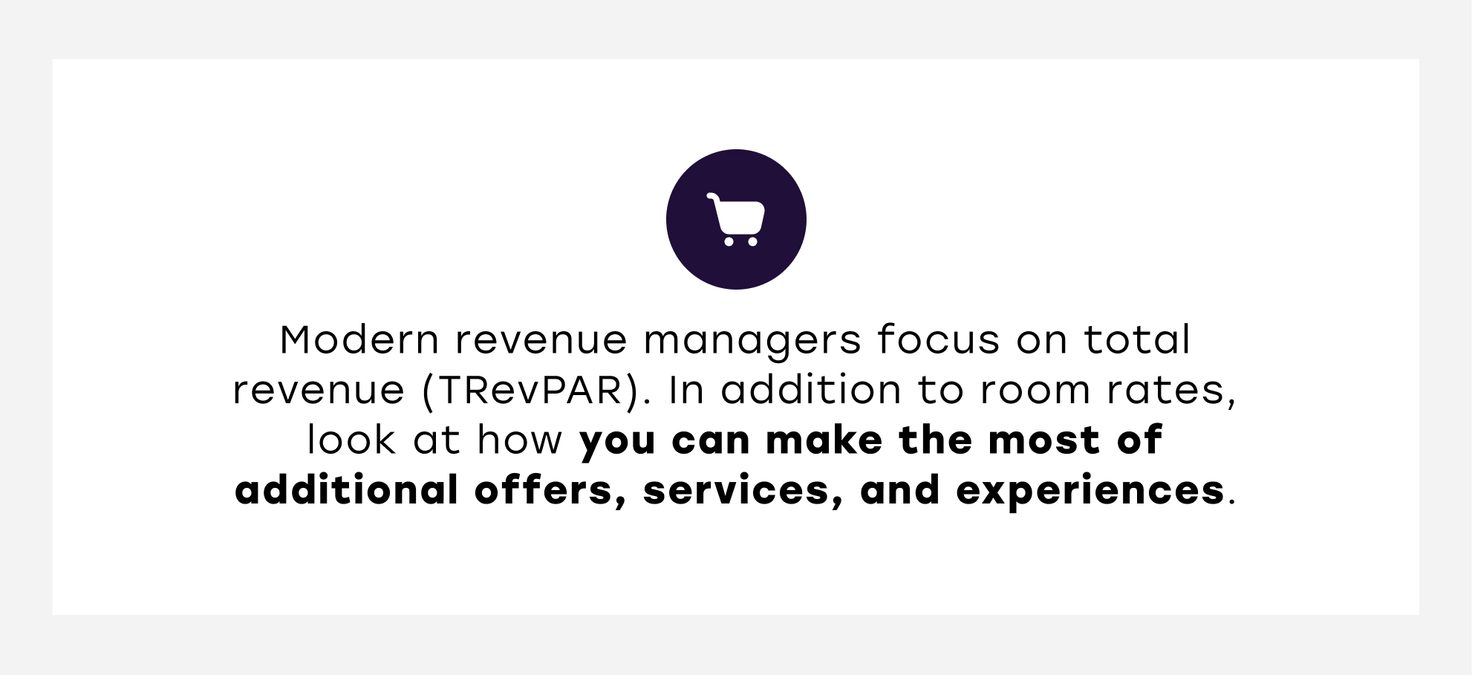
What is hotel pricing compliance?
Hotel pricing compliance involves ensuring that room rates and charges are accurate and consistent across all booking channels. At the end of the day, hotels also have legal, contractual, and ethical obligations and hotel pricing compliance will help avoid running into any issues.
For example, in many regions, consumer protection and competition laws regulate how hotels display and promote prices. Non-compliance, such as misleading discounts, unfair cancellation policies, or hidden fees, can trigger fines and legal disputes.
That said, it’s not just about pleasing authorities. It will build trust among your target guests, helping to generate repeat business.
What tools or software help with hotel pricing?
1. Revenue management system (RMS)
Hotel revenue management systems like IDeaS, Duetto, and Atomize are specialized tools that help hotels optimize pricing and maximize profit. They continuously monitor booking trends, occupancy levels, demand patterns, and competitor rates. Based on these real-time marketing data, they adjust the room price automatically.
The fact that they also consider what other hotels in the area are charging means that you’ll remain competitive without having to use solely competitor-based pricing.
In addition to real-time data, these tools can also pull historical data to forecast demand. This way, you’ll know which will be the best pricing strategies for certain periods in advance.
As it eliminates manual price adjustment, it also becomes a tool to help improve hotel efficiency.
Systems like IDeaS and Duetto can be seamlessly integrated with Oaky, enabling dynamic pricing to work also for room upgrades. This can help move the revenue needle even further, as you can capitalize on room upgrades in addition to regular room sales.
2. Hotel upselling software
Hotel upsell software, like Oaky, supports a strategic pricing approach by monetizing room upgrades, service, and experiences, and maximizing revenue per guest all year round. With Oaky’s automated upselling, you can:
Drive profitability and stay competitive without increasing your room rates
Reduce team workload, saving time on routine tasks and motivating your team
Enhance the guest experience and enjoy extra convenience by allowing guests to purchase services and upgrades directly from the hotel.
For example, when used in relation to your pricing strategy, you can start upselling pre-arrival, at the front desk, and in-stay, maximizing your TRevPAR by up to 5%.
See Pre-Stay Upsell in action!
Plus, with the new Bidding feature, hotels can maximize revenue even further. Instead of giving away upgrades for free (for example, during the low season), you can still charge an amount as suggested by the guest. This way, you gamify upselling and collect data on how much hotel guests are willing to pay for certain upgrades along the way to help you enhance your overall revenue management strategy.
You’ll notice how your customer satisfaction increases, too. Guests respond positively as they view it as a way to customize their stay and remain in control of their spending.
2. Property management system (PMS) with pricing features
Property management systems like Opera PMS or Mews act as a central hub for data about reservations, inventory, and pricing, giving you a real-time overview of occupancy levels. You’ll see how many rooms are occupied, reserved, and out of service, allowing you to adjust your pricing accordingly. For example, if you see that many premium rooms are still available, you can start to push upselling more.
Plus, as most modern systems include rate management tools, you can create pricing rules so that price changes are made automatically. For example, if there’s a conference scheduled for September, you can set it up so that length-of-stay pricing kicks in a few weeks before this event.
3. Channel managers
Channel managers like SiteMinder, Cloudbeds, and STAAH can help hotels sync their room inventory and pricing across multiple distribution channels accurately. Similar to your PMS, it acts like a central dashboard where you can set the availability, pricing, and restrictions. From there, the software will see to it that it gets updated automatically, preventing hotel overbooking and eliminating manual errors.
As all the rooms will be priced consistently, it’s a must-have tool if you want to adopt a rate parity strategy.
It can also help with hotel dynamic pricing when it’s integrated with your RMS.
How to ensure competitive hotel pricing
Ensuring competitive pricing is about balancing guest appeal with profitability. Here are the most effective ways to gain a competitive advantage:
Analyze your hotel’s comp set: Compare rates with similar hotels in your location, category, and with comparable amenities.
Use hotel dynamic pricing tools: Platforms like Duetto, IDeaS, and the like give real-time data on competitor pricing and demand trends.
Segment your guests: Business travelers, leisure guests, and groups often have different price sensitivities and booking behaviors.
Focus on value-based pricing: Instead of relying only on discounts, create packages, add-ons, or upsells that increase perceived value.
Use hotel upsell software: Filling rooms, including premium ones, without discounts, ensure profitability without increasing rates to stay competitive and attractive to guests. Make use of your entire inventory - from rooms to services and exclusive experiences.
Maintain rate parity: Keep your hotel pricing consistent across OTAs and your direct booking channels to build trust.
All in all, the key is to match the right price to the right guest at the right time—helping you stay competitive while protecting margins.
